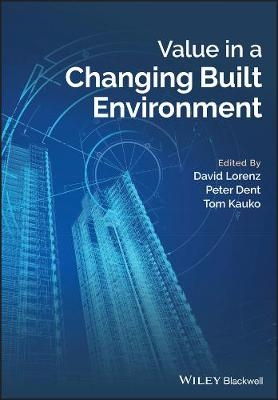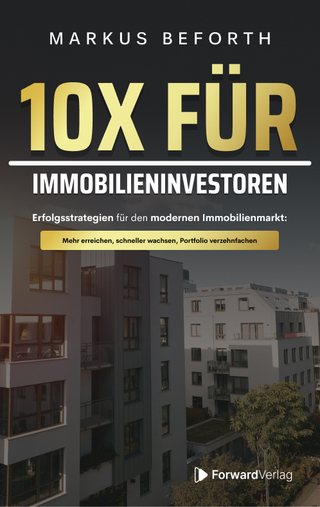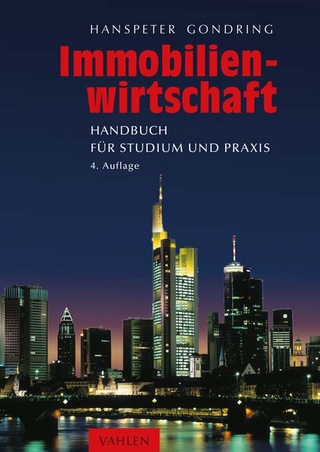
Value in a Changing Built Environment
Wiley-Blackwell (Verlag)
978-1-4443-3476-0 (ISBN)
- Titel z.Zt. nicht lieferbar
- Versandkostenfrei innerhalb Deutschlands
- Auch auf Rechnung
- Verfügbarkeit in der Filiale vor Ort prüfen
- Artikel merken
Value in a Changing Built Environment examines the professional foundations on which the valuation exercise and the valuation profession rest. Written by noted experts in the field, the book addresses the often limited understanding of the concept of property value by explaining the intrinsic linkages between economic, environmental, social, and cultural measures and components of property value. The book offers a framework that paves the way towards a more holistic approach to property value.
Value in a Changing Built Environment unwraps many of the traditional assumptions that have underpinned market participants’ decision making over the last few decades. The authors explore the concept that a blindfold application of valuation theories and approaches adopted from finance is unlikely to be able to cope with the nature of property as an economic and public good. This vital resource:
Explains the criteria for making estimates of value that can be applied worldwide
Offers an integrated approach to property value and the valuation processes
Captures the often illusive intangibles such as environmental performance into valuation
Addresses a market failure to account for wider criteria on building performance
Value in a Changing Built Environment examines how real estate valuation plays a pivotal role in decision making and how can a new body of knowledge improve the practice in both business and social domains.
DAVID LORENZ is co-chair of the Centre for Real Estate at the Karlsruhe Institute of Technology (KIT) where he is Professor for Property Valuation and Sustainability. David is also the director and founder of a real estate management, valuation and consulting firm located in the southern part of Germany. He has more than 15 years of experience in valuation, asset management and property development, has published extensively on the role of sustainability in real estate management and valuation, and is a Fellow and Spokesperson of the Royal Institution of Chartered Surveyors (RICS). In the past he was actively engaged with several research projects administered by RICS and the UN. PETER DENT is affiliated to Oxford Brookes University where he currently participates in International programmes in real estate valuation and finance. For eight years he was the Head of the Department of Real Estate and Construction before taking up the post of Comerford Climate Change Fellow in 2008. Latterly he was Director of International Programmes helping to develop and manage professional and academic programmes. During his career he has published widely including two books: Property Markets and Sustainable Behaviour (2012) and Towers, Turbines and Transmission Lines: Impacts on Property Value (2013). TOM KAUKO is an academic labourer with wide remit within real estate economy and urban affairs. He received a M.Sc. degree in Real Estate in 1994 (Helsinki University of Tech, Finland), and a Ph.D. in Geography in 2002 (Utrecht University, The Netherlands). He has worked for Oxford Brookes University, UK, the Norwegian University of Science and Technology and OTB Research Institute, Delft University of Technology, The Netherlands. He has carried out research on urban real estate, housing and land-use studies. He is currently based in the historic seaside town of Portsmouth (UK), where he works with lecturing and research for the School of Civil Engineering and Surveying at the University of Portsmouth. His interest is in strategic issues such as valuation, sustainability, urban renewal, resilience, and innovations, and related spatial development and town planning issues. He has over 70 publications and c. 100 conference presentations.
About the Editors xi
Note on Contributors xiii
Introduction 1
The Book’s Main Theme 2
The Book’s Key Messages 3
The Book’s Methodology and Starting Points 5
Brief Description of the Current State of Affairs, Developments and Changes 5
Analysis of Likely Consequences for Valuers, Valuation Theory and Practice 7
Explanation for Proposing Alternative Protocol to Valuation and Decision-Making Processes in the Property Industry 9
Part 1 Gap Analysis: Anomalies and Paradoxes, Questions, Dilemmas and Motivations 13
Tom Kauko, Peter Dent, Stephen Hill, Maurizio d’Amato and David Lorenz
Background 13
Property Market Impacts 15
Out of the Comfort Zone 15
The Social Mind 19
Lack of Political Awareness in the Profession about Changes in Value Systems 20
Professional Values 21
‘Wrong Coding’ of the Market System 22
Lack of Linkages to Any Belief System 24
Concluding Remarks 26
Part 2 A Theory of Value in the Built Environment 29
2.0 Introduction 29
Peter Dent
Property Ownership 30
Cognitive Economy 30
Behavioural Characteristics 31
Moral Values 31
Sustainable Decision-Making 33
2.1 Economic Value: Value, Price andWorth 34
Peter Dent and David Lorenz
The Dominant Economic System 34
Rational Knowledge 35
Value 36
Price 39
Worth 40
Concluding Remarks 42
2.2 Sense and Categories of Value 43
David Lorenz, Peter Dent, Tom Kauko, Thomas Lützkendorf and Stephen Hill
Sense of Value 44
Categories of Value 45
Part 3 Valuation Methodology 51
3.0 Introduction 51
David Lorenz and Tom Kauko
3.1 Aspects of Residential Value AnalysisMethodology 53
Tom Kauko
Introduction 53
Conceptualisation 55
Methodology 58
Practical Applications 61
Summary and Concluding Discussion 62
3.2 Aspects of Commercial Property Valuation and Regressed DCF 63
Maurizio d’Amato
Regressed DCF 64
Discount Rate, Risk Premium Determination, and
Regressed DCF 65
An Application of Regressed Models A, B, and C to Bucharest
Commercial Real-Estate Market 66
Model A 68
Model B 73
Model C 77
A Real-Estate Market Risk Premium Map 81
Conclusions and Further Directions of Research 83
3.3 The Significance of Land Attributes in Determining the Types of Land Use 84
Malgorzata Reniger-Bilozor and Andrzej Bilozor
Introduction 84
Method for Determining the Effect of Real-Estate Attributes on Land-Use Function with the Use of the Rough Set Theory 85
Concluding Remarks 95
Part 4 Empirical Applications of Market Analysis 97
4.0 Introduction 97
Tom Kauko
Shift in Focus 97
Presentation of Individual Chapter Summaries 99
4.1 Directions for Exploration of NewMethods of Identifying and Determining Relationships and Dependencies on the Real-Estate Market 102
Malgorzata Renigier-Bilozor and RadoslawWisniewski
Introduction 102
The Real-Estate Sector – Analysis and Challenges 104
The Real-Estate Market System 105
The Participants (Entities) of the Real-Estate Market 107
Real Estate and Its Characteristics 109
Research and AnalyticalMethods 111
4.2 Economic Sustainability, Valuation Automata and Local Price Development 119
Tom Kauko
Introduction 119
The Need for a Sustainable Housing Market 121
The New Paradigm of Modelling Value – Is AVM the Solution? 124
Designing an Empirical Modelling Method 126
Data Preparation 129
The Results of the Analysis 130
The Principle of Smoothing the Value Using a SOM Approach 132
Conclusions and Discussion 134
4.3 Evaluation of Selected Real-EstateMarkets – A Case Study from Poland 137
Malgorzata Renigier-Bilozor and RadoslawWisniewski
Introduction 137
Perfect versus Imperfect Real-Estate Markets 138
Analysis of Selected Real-Estate Markets in Poland – Case Study 139
The Use of the Rough Set Theory in Real-Estate Market Analysis 148
Conclusions 150
4.4 Cyclical Capitalization 151
Maurizio d’Amato
Introduction 151
Real-Estate Market Cycle 152
Income Approach and International Valuation Standards 153
Cyclical Capitalization 155
The Primum Group of Cyclical Capitalization 157
The Meaning of g Factor or Δa 157
The Primum Group 157
The Secundum Group of Cyclical CapitalizationMethods 162
The Tertium Group of Cyclical CapitalizationMethods 164
The Quartum Group of Cyclical CapitalizationMethods 166
Application of Cyclical CapitalizationModels to London Office Market 167
Time-Series Analysis for Cyclical Capitalization Application 167
Conclusions 171
Part 5 Towards a More Sustainable Real-EstateMarket 173
5.0 Introduction 173
Peter Dent
5.1 Professional Responsibility 175
Stephen Hill, David Lorenz, Peter Dent and Thomas Lützkendorf
Introduction 175
Built-Environment Professionalism and Professional Bodies 176
General Guiding Principles and Role within the Institutional Framework 176
Professional Bodies at Risk 177
Sustainability Literacy in Built-Environment Professionalism 178
The Ethics of Built-Environment Professionalism 179
Professional Disciplines in a Social, Environmental and Economic
Context 179
How Ethical Are Professional Codes of Conduct? 181
European Institutions 183
Responsibility and Accountability for Outcomes: Future Professionals 186
Taking Personal Responsibility for the Other 189
Professional Sustainable Practices 191
5.2 Professional Approach 194
Peter Dent and David Lorenz
Introduction 194
Bottom-Line Approaches 195
AWay Forward 196
Proposed Changes Regarding Current Valuation Practice and Standards 198
Conclusion 198
Appendices 201
References 213
Index 231
| Erscheinungsdatum | 31.01.2018 |
|---|---|
| Verlagsort | Hoboken |
| Sprache | englisch |
| Maße | 170 x 244 mm |
| Gewicht | 476 g |
| Themenwelt | Wirtschaft ► Betriebswirtschaft / Management ► Rechnungswesen / Bilanzen |
| Betriebswirtschaft / Management ► Spezielle Betriebswirtschaftslehre ► Immobilienwirtschaft | |
| ISBN-10 | 1-4443-3476-X / 144433476X |
| ISBN-13 | 978-1-4443-3476-0 / 9781444334760 |
| Zustand | Neuware |
| Haben Sie eine Frage zum Produkt? |
aus dem Bereich


